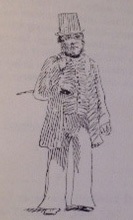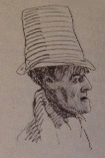Early use of herbs in Hitchin and the surrounding areas.
by Bob Press, Physic Garden volunteer and professional botanist
Herbs have a long history as sources of flavourings, preservatives, dyes and other household reparations and, especially as medicines. In the Hitchin area, as elsewhere, basic everyday knowledge of herbs and how to use them medicinally was widespread, with recipes handed down through generations. But access to more specialist knowledge could be gained in other ways and there are records of several local herbal practitioners who could be consulted.
The Apothecary
In 1711 the apothecary Thomas Ward agreed to “take care of all the poor in the town and use his best skill in cureing (sic) all fevers, small poxes and all other distempers that belong to the Physician” for the sum of £6.00.
The Vicar
Not everyone could afford specialist advice but poorer people could make use of a parish herbal to research diseases and treatments. In the mid-18th century the Rev. Mark Hildesley was one of several local vicars who kept such a work – appropriately in this case Culpepper’s Medicaments for the Poor, or Physic for the Common People- for just this purpose. This was medicine on the cheap. Such self-diagnosis might be risky but many ingredients for remedies were available in the fields and hedgerows around the town for free.
The Herb Doctor

Richard Crofts, herb doctor
Alternatively folk might chose a private consultation with the local herbal doctor Richard Croft– a snip at sixpence. Croft walked to Hitchin from nearby Great Wymondley every Tuesday to set up the market stall from which he sold herbs.
The Peripatetic Physician

‘Dr’ Mansel, physician
In 1820 a rival to Richard Croft appeared in Hitchin. Despite lacking qualifications – his only experience as a physician was on board whaling ships – ‘Dr’ Mansel began practising in the town, earning a reputation for treating tumours. He had no consulting room, preferring to tout for trade at the regular Tuesday market instead. Examinations and treatment took place in the street. A prescription to take to the chemist cost sixpence (the chemist charged a further sixpence to make it up) but Mansel also sold his own remedies made from herbs he collected in the fields around the nearby village of Gosmore. He also attended childbirths, charging five shillings for a live birth but nothing in the event of a death. Whatever his medical abilities, Mansel was a popular physician among the poorer people of the area, perhaps because of his low fees. Descendants of ‘Dr’ Mansel still live in Hitchin.
Commercial production
William Ransom & Son
The first commercial scale production using herbs began in 1846. William Ransom, a member of a prominent local Quaker family, established a factory for the commercial production of natural, botanical and plant extracts for the food, drink, pharmaceutical industries. The factory was situated on the edge of the town centre in Bancroft until it was demolished in 2005. Large quantities of herbs were dried, distilled or otherwise processed there before being sent out to retailers.
Herbs such as liquorice and cascara were imported from abroad and seaweed and mulberries from elsewhere in the UK but the mainstays of the business were the herbs grown around Hitchin and Meppershall (Bedfordshire) on Ransom’s own land. A long list included peppermint and chamomile, as well as poisonous species such as deadly nightshade, henbane and foxglove. The land around Hitchin has light, loamy and well-drained soil, ideal for growing many herbs and cultivated plants generally give a higher yield of active compounds than wild ones.
Nevertheless, wild-collected plants were also in demand and provided a useful, if erratic, income for locals. Dandelions (mainly used in coffee at the time) were bought from collectors and as many as 20 tons might be brought to the factory door on a Saturday morning. The practise of wild-collecting continued into the late 20th century.
Perks & Llewellyn
John Perks opened his chemist’s shop in Hitchin High Street in 1790. In 1823 Edward Perks began making lavender products for sale via the shop. His son William further developed the business. In 1876 grandson Samuel took over and by 1878, in partnership with local farmer Charles Llewellyn, had 35 acres of lavender in cultivation.
Lavender was harvested with a sickle and transported from the fields to the rear yard of the shop where the flower heads were stripped from the stalks. Distilling the aromatic oil from the flower heads was carried out at William Ransom’s factory just down the road.
The shop was eventually taken over by Richard Lewis in 1906. The last shop owner was his daughter, Violet Lewis, a trained pharmacist who ran the business from 1930 to 1961. Perks and Llewellyn lavender products were still sold until the business closed. When Violet sold the shop site to developers she saved the historic interior of the chemist shop which dated back to its inception in 1790. This is now preserved partly in North Herts Museum and partly at Hitchin Lavender, and represents a tradition of growing, preparing and selling lavender in Hitchin stretching over 225 years.
Herbs in Hitchin today
While herbalism has moved on from its folk-lore beginnings, plant products remain vital in the food and pharmaceutical industries and to Hitchin as a town. Local people still gather herbs from the wild, though they are no longer sold to the factories. But William Ransom’s company continues (as Ransoms Natural Products) and this family firm is still a major employer in Hitchin. The lavender industry also survives. In 2000, the Hunter family began growing English lavender at Cadwell Farm, a literally flourishing concern which ensures Hitchin remains one of the main centres for growing lavender in England.